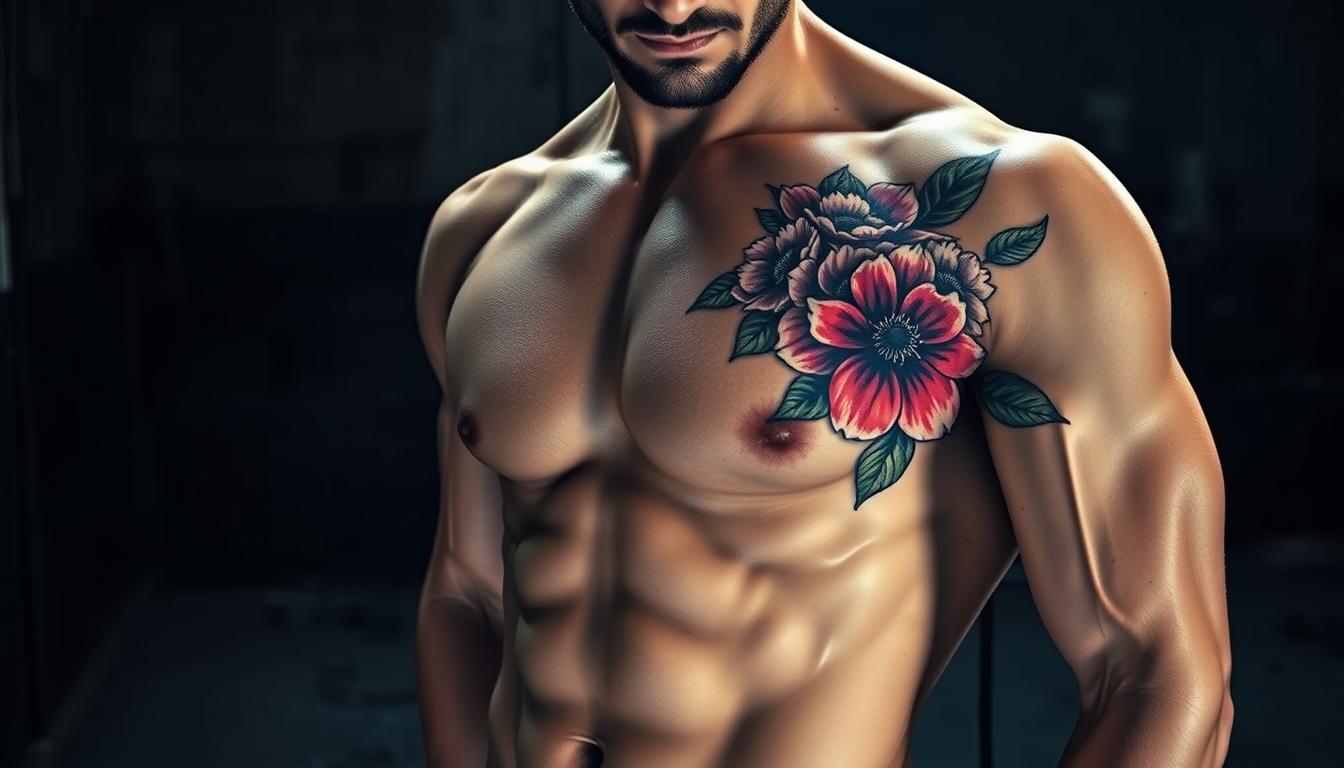
Botanical body art has shed outdated stereotypes, emerging as a bold medium for self-expression. What was once considered niche now represents strength, individuality, and connection to nature through carefully crafted symbolism. From lotus blossoms symbolizing perseverance to roses embodying resilience, these designs blend organic elegance with striking visual impact.
Contemporary artists reimagine floral motifs with geometric accents, textured shading, and minimalist linework. This evolution allows wearers to showcase personal stories while maintaining a distinctly rugged aesthetic. Whether you prefer subtle wrist pieces or full-sleeve masterpieces, versatile floral designs adapt to your unique style narrative.
The best creations balance timeless meaning with modern execution. A sunflower might represent optimism through vibrant color blocking, while a lily could symbolize renewal via abstract watercolor techniques. These artistic choices transform traditional botanical imagery into powerful statements that defy conventional gender expectations.
Key Takeaways
- Modern floral ink challenges old stereotypes, offering masculine designs that blend nature with bold artistry
- Specific blooms carry deep symbolism – lotus for overcoming challenges, roses for enduring strength
- Artists use innovative techniques like geometric shapes and textured shading to enhance traditional motifs
- Designs range from discreet placements to elaborate compositions, fitting various style preferences
- These pieces serve as personal emblems of growth, heritage, or life-changing experiences
Introduction to Floral Tattoos in Masculine Ink
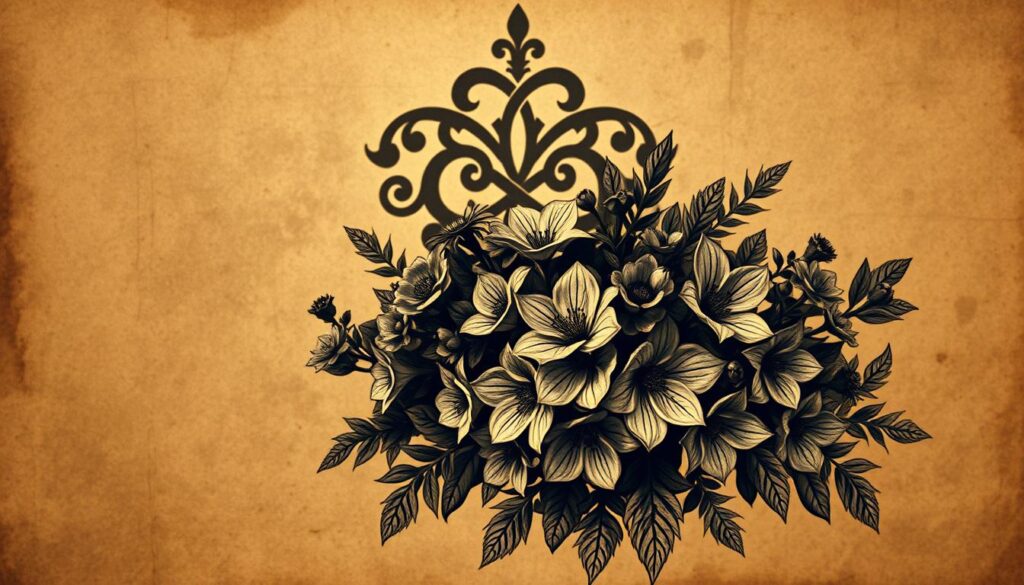
Gone are the days when botanical body art was boxed into rigid gender categories. Today’s designs honor centuries of tradition while carving new paths for personal storytelling. What began as sailor badges of honor now thrives as versatile symbolism – proving nature’s motifs speak universally.
Historical & Cultural Inspirations
Early 20th-century American workers wore roses as emblems of resilience. Sailors inked chrysanthemums to commemorate voyages. These roots reveal how organic imagery became intertwined with masculine narratives long before modern trends. Cultural traditions from Japanese irezumi to Polynesian patterns further enriched floral symbolism.
Breaking Gender Stereotypes in Tattoo Art
Your choice to wear botanical designs challenges outdated norms. Artists now blend delicate petals with bold linework, creating pieces that radiate both power and vulnerability. As one tattooer notes: “True artistry doesn’t check boxes – it sparks conversations.”
This shift lets you prioritize meaning over stereotypes. A peony might honor family heritage. Geometric thistles could symbolize overcoming hardships. Your skin becomes a canvas where strength meets nuance, rewriting expectations with every bloom.
Flower Tattoos for Men: Modern Trends and Timeless Meanings
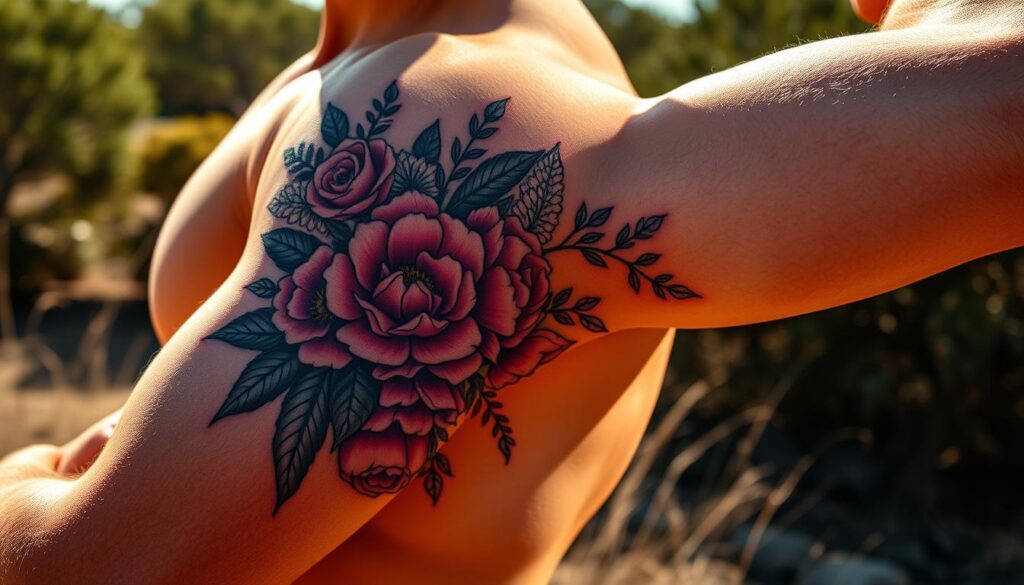
Modern ink enthusiasts are redefining personal expression through nature-inspired designs. These creations blend organic beauty with bold artistry, challenging outdated perceptions. Each piece serves as a visual manifesto – where delicate petals meet unapologetic strength.
Why This Style Resonates Today
Cultural shifts now encourage embracing diverse symbols without compromising identity. Artists amplify this through geometric linework and dark shading techniques. “Clients want their stories told, not just their skin decorated,” explains Brooklyn-based tattooist Marco Velez.
This approach transforms traditional motifs into power statements. A chrysanthemum might pair with barbed wire to symbolize endurance. Oak leaves could intertwine with compasses, representing rooted ambition.
Key Symbolic Elements in Contemporary Ink
Every botanical choice carries layered significance. Peonies embody prosperity, while thistles signify defiance against adversity. Lotuses often represent rebirth through intricate dotwork patterns.
Modern designs frequently combine multiple elements. You might see maple leaves for growth alongside abstract storm clouds. These combinations create deeply personal narratives etched in ink.
Artists balance symbolism with striking visuals. Monochromatic shading adds depth to magnolias, suggesting quiet confidence. Contrasting textures make tiger lilies pop, celebrating untamed individuality.
Bold and Masculine Rose Tattoos
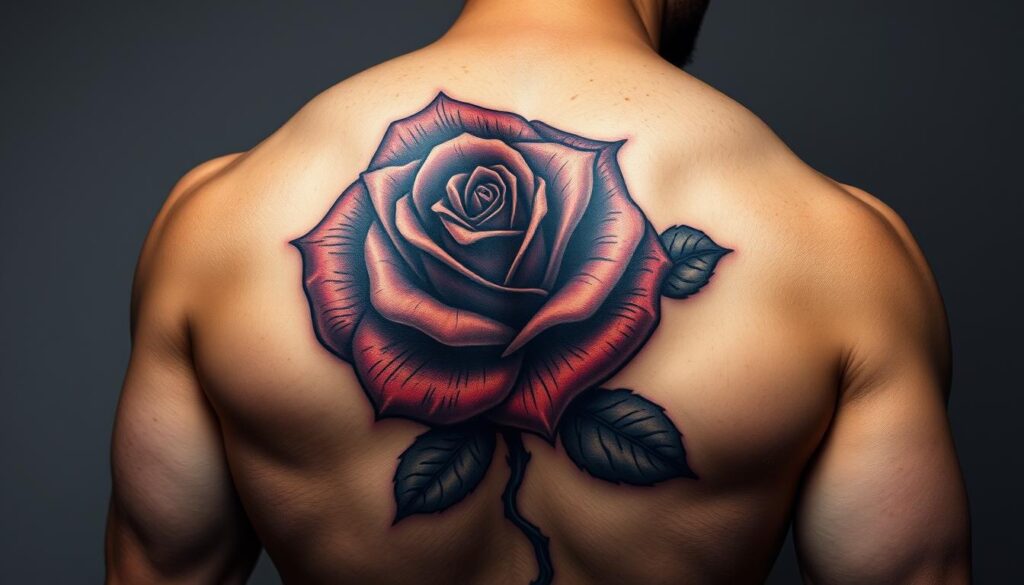
Roses in ink defy expectations, merging delicate beauty with unapologetic strength. Modern interpretations use shadow play and symbolic details to create pieces that radiate power. These designs prove organic elegance can coexist with rugged appeal, especially when executed with precision.
Detailed Shading and Symbolism
Artists transform petals into 3D masterpieces using charcoal-like gradients. Darker tones at the base create depth, while strategic highlights make blooms appear lifelike. One veteran tattooer notes: “Shading isn’t just technique—it’s how we infuse emotion into every thorn and petal.”
Thorns along stems add layers of meaning. They symbolize resilience without overshadowing the rose’s inherent grace. This balance makes the rose tattoo design a versatile canvas for personal stories.
Versatile Placement Ideas
Your body becomes a gallery for these striking pieces. Consider these popular locations:
| Placement | Visual Impact | Symbolic Weight |
|---|---|---|
| Inner Forearm | Subtle visibility | Personal reminder |
| Chest | Bold statement | Heart-centered values |
| Neck | High contrast | Unapologetic confidence |
Bolder areas amplify the rose’s duality—soft curves against unyielding skin. Smaller versions work equally well behind ears or on fingers, proving adaptability is key.
Creative Sleeve and Full-Arm Floral Tattoos
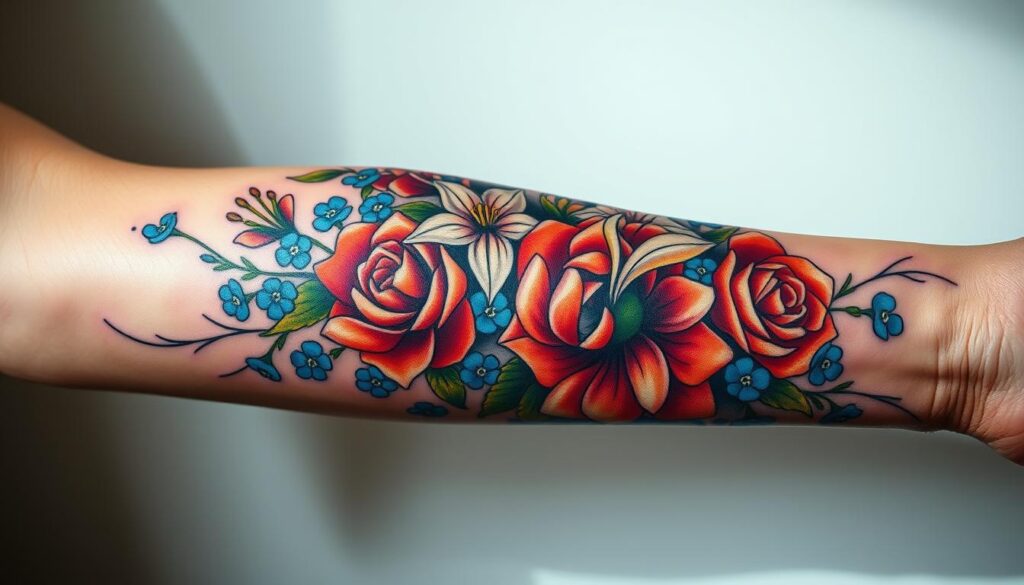
Full-arm botanical art transforms skin into a dynamic storytelling canvas. Artists craft bold compositions using blackout bases and negative space, balancing dark intensity with intricate details. This approach lets you showcase rebellion through shadows while maintaining organic elegance.
Integrating Motifs Like Skulls and Compasses
Pairing roses with skulls creates striking contrasts – life meets mortality, beauty clashes with grit. A compass embedded in chrysanthemums might chart personal growth through thorny vines. “These combinations aren’t random – they’re visual poetry,” says San Diego artist Luis Moreno.
Consider these symbolic pairings:
- Peonies with pocket watches: fleeting beauty meets timeless values
- Maple leaves with storm clouds: resilience through challenges
- Lotus blossoms with anchor motifs: stability amid transformation
Creating a Cohesive Story on Your Skin
Your sleeve becomes a narrative when elements flow naturally. Start with a focal point – maybe a skull shoulder piece – then let vines cascade toward wrist compasses. Dark shading connects separate symbols into one unified landscape.
| Element Placement | Visual Effect | Storytelling Role |
|---|---|---|
| Upper Arm | Dominant feature | Central theme |
| Forearm | Interactive view | Personal journey |
| Wrist | Subtle closure | Future aspirations |
Work with your artist to map transitions. Geometric lines might frame floral clusters, while negative space highlights key symbols. The result? A wearable epic that evolves with every glance.
Minimalist and Small Flower Tattoos for a Subtle Impact
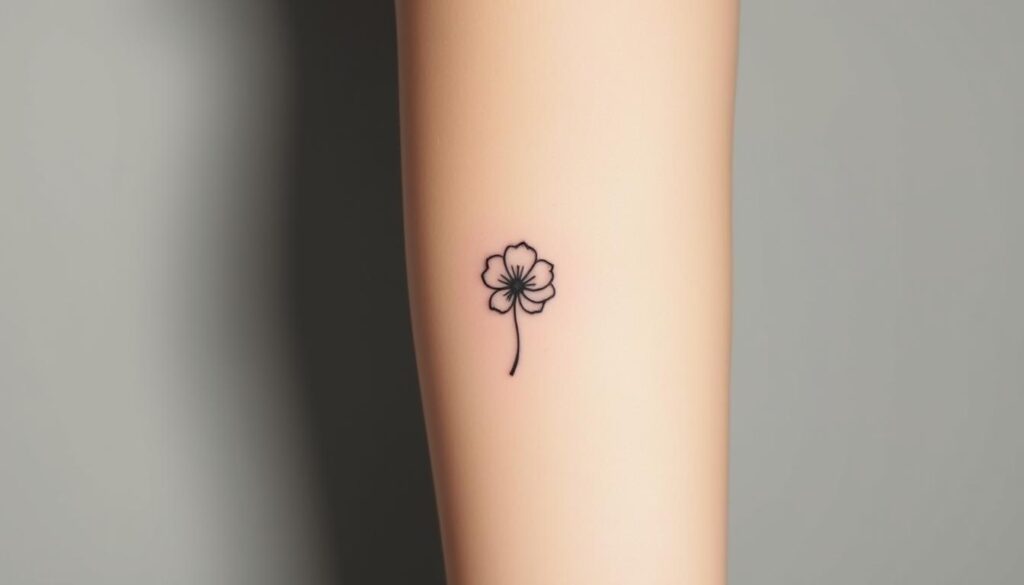
In a world of bold statements, subtlety speaks volumes through precise botanical ink. These compact designs prove size doesn’t dictate significance – a single bloom etched with intention can convey depth while maintaining understated elegance.
Crisp linework forms the backbone of minimalist pieces. Artists transform complex petals into flowing contours using unbroken strokes. “One shaky line ruins the entire composition,” warns Portland-based tattooist Jenna Cole. This technical mastery elevates simple concepts into wearable art.
| Design Element | Visual Effect | Skill Required |
|---|---|---|
| Single-Needle Lines | Clean, sharp definition | Steady hand precision |
| Grey Wash Shading | Soft dimensional depth | Gradient control |
| Negative Space | Modern simplicity | Strategic planning |
Strategic shading adds whispered dimension without overpowering. A hint of grey inside rose petals suggests inner fire, while open spaces let skin become part of the artwork. These choices create dialogue between ink and canvas.
Your selection of discreet placement – behind the ear or along collarbones – amplifies the design’s intimacy. It becomes a personal emblem rather than public spectacle. This approach celebrates confidence through restraint, letting craftsmanship shine without unnecessary embellishment.
Japanese-Inspired Flower Tattoos: Cherry Blossoms & Lotuses
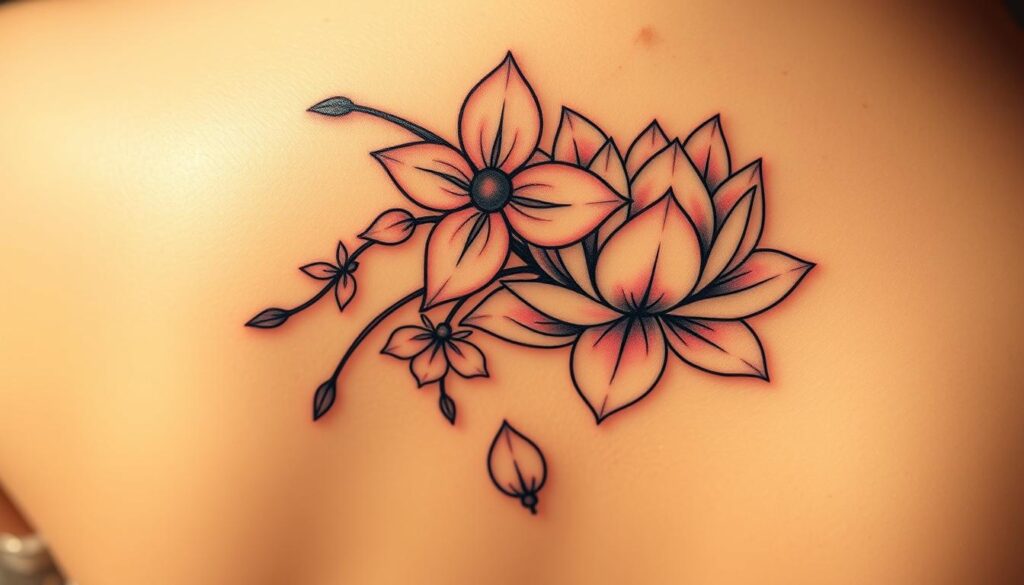
Ancient philosophies meet modern skin art through Japan’s iconic botanical symbols. These designs carry centuries of meaning while adapting to contemporary aesthetics. Your choice to wear them becomes a bridge between cultural wisdom and personal expression.
Symbolism and Cultural Significance
Sakura (cherry blossoms) embody life’s fleeting beauty. Their two-week bloom period inspires hanami festivals, where communities gather under pink canopies. As one Osaka tattoo master observes: “We ink sakura not just for their looks, but to carry spring’s transient magic year-round.”
Lotus motifs tell stories of triumph over adversity. Emerging from muddy waters, they symbolize spiritual clarity through intricate petal patterns. Many designs pair them with koi fish or waves, enhancing their connection to perseverance.
| Symbol | Meaning | Design Tip |
|---|---|---|
| Cherry Blossoms | Life’s fragility, renewal | Use falling petals for motion |
| Lotus | Inner transformation | Add water ripples below |
| Peony | Prosperity, honor | Combine with samurai imagery |
Modern artists reinterpret these elements with bold outlines and strategic shading. A sleeve might feature sakura branches transitioning into lotus ponds, symbolizing personal growth. Darker color palettes maintain masculine energy while respecting traditional symbolism.
Your design gains depth when layered with cultural context. A single blossom behind the ear whispers mindfulness. A full-back lotus becomes a testament to overcoming life’s murkiest challenges. Each piece honors heritage while carving new meaning.
Abstract and Geometric Flower Tattoo Designs
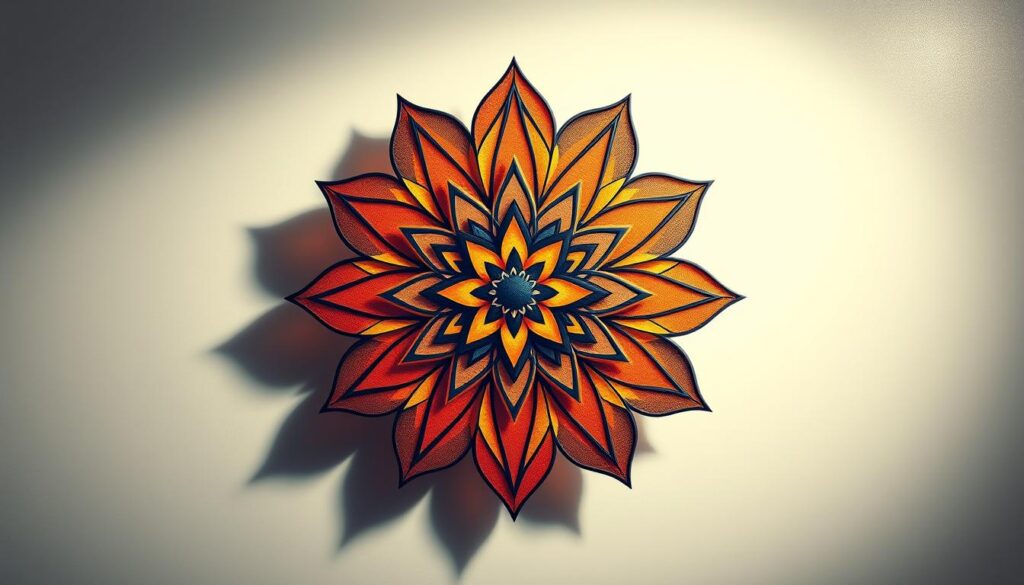
Breaking traditional molds, contemporary body art reimagines botanical motifs through angular precision and creative distortion. These dynamic compositions transform familiar blooms into bold statements where geometry meets organic flow. Sharp angles might slice through rose petals, while intersecting circles could reconstruct a lotus – each element challenges expectations while retaining symbolic roots.
Expressive linework becomes the star in these creations. “Our clients want their ink to feel alive, even when frozen on skin,” shares Chicago artist Tessa Nguyen. Jagged strokes suggest windblown petals, while overlapping triangles create depth in minimalist daisies. This approach lets your energy shine through calculated imperfections.
| Design Approach | Visual Impact | Skill Level |
|---|---|---|
| Abstract Florals | Emotional intensity | Advanced composition |
| Geometric Patterns | Architectural balance | Precision linework |
| Linework Focus | Raw energy | Single-needle mastery |
These styles offer endless customization. An artist might deconstruct magnolias into hexagons for tech enthusiasts or weave simple floral concepts into fractal patterns. The best designs balance chaos and control – wild ink splatters contained by crisp borders.
Modern symbolism thrives in this space. What appears as random shapes often hides meaningful configurations – maybe a hidden compass in sunflower rays or birthdate angles within cherry blossoms. Your piece becomes a puzzle that rewards closer inspection.
Edgy and Modern Black & Grey Floral Ink
Monochrome botanical artistry redefines masculinity through stark contrasts and technical precision. This style transforms organic shapes into striking graphic statements using only ink’s purest forms – jet-black pigments and nuanced grey washes.
Mastering Depth Through Light Play
Your artist becomes a shadow architect with these pieces. Thick outlines carve bold silhouettes, while gradient shading adds dimension to every petal. Darkest areas anchor the design, creating illusions of depth that make 2D skin feel three-dimensional.
Skilled practitioners layer up to seven grey tones for photorealistic effects. A single bloom might transition from coal-black centers to feather-light edges. This technique highlights natural beauty without color distractions, letting texture and form take center stage.
Modern approaches balance edginess with delicacy. Razor-sharp lines frame soft shading transitions, proving contrast drives visual impact. “Blackwork floral pieces demand perfect execution – there’s nowhere to hide mistakes,” notes award-winning ink specialist Elena Torres.
These designs thrive on intentional simplicity. Your piece might feature a single magnolia with hyper-detailed stamen, or wild roses with geometric negative space. Each choice celebrates botanical complexity through monochromatic mastery.
